My 2AA battery sensor
-
@m26872 here is my complete description for MySensors door/window sensor. For other sensors I will add descriptions in the future...
-
@dopustko Great! I love your low-power guide. Wow! That should be mandatory for all sensors that work below 3.3V like e.g. a door switch. And you're able to use the internal battery monitoring method and all.
Also, when I looked at your diagram I realized that I probably did a mistake with my door switch connection to arduino and have a substantial current draw through the switch. If true it means that the step-up is innocent.
-
@m26872 In fact most of sensors can work on 2 AA batteries without step up regulator if sensor is selected carefully. That also minimize number of components and battery consumption.
I'm using 1M pull up resistor instead of internal resistor (50-60K) - this lower power consumption. 1M is quite big but wires are short, so it's working ok.
-
Hi @dopustko , i've checked your cool website. can I ask few question regarding your setup?
I saw this page, in order to get low power consumption, you did burn fuse and disable brown-out? Possible to use it without usbtinyisp?
-
@funky81 Thx. You can burn fuses with other Arduino - that's how I do it. Just google ArduinoISP.
-
Good info here. Thought comes to mind about using a small solar cell off a defectivet walkway light to add a little charge back in to the system, when there is any kind of light around.
-
Just an update on my battery levels. My VeraLite Datamine-plugin won't longer plot for me. I suspect I'm out of VeraLite memory to handle all the data. This is it. (Look above for last graphs.)
Node 16: BatteryLevel 51
Node 101: Dead 03 Feb
Node 110; BatteryLevel 57
Node 105: BatteryLevel 80
Node 106: BatteryLevel 53
As I hoped, the decrease rate for 105 and 106 is now less than 5% per month and 6-month target is already passed by half.
The revenge of the Chinese step-up ?!
-
Someone else noticed that one of the two batteries drained by the step-up always has negative(!) charge? Due to the AC-load? Could it be possible to extend battery life by adding some kind of capacitor?
-
Node 105 and 106 down just 1% since last post (22 days ago). Not bad. Relatively stable readings and low activity, but it doesn't matter since we're all expected the sleep mode consumption to be the worst.
-
@EasyIoT: Thank you for your nice descriptions of the low power sensors.
I have some questions regarding the temperature sensor:
Did you use a "Low power modified" Arduino for that as well?
How are you able to power the sensor via the step-up only when needed? Do you power the step-up via an digital pin or something?@m26872: Also thanks for your design. I am thinking of building something similar. So you got now about 5% battery drop per month using the china stepup with desoldered LED?
-
@daenny said:
So you got now about 5% battery drop per month using the china stepup with desoldered LED?
Today I read Node 105: 78% and Node 106: 51%. That's only 2% in the last 38 days.
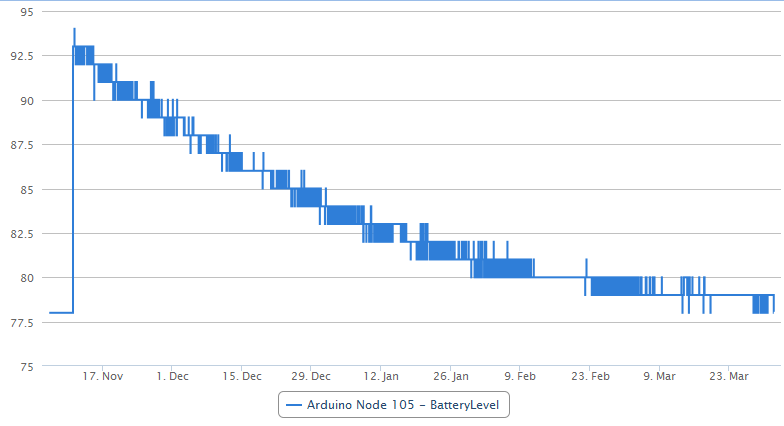
Edit: Perhaps using the "%" here is a little careless, but I think everyone knows that we're talking battery level.
-
@daenny yes, I'm using DO pin and MOSFET connected to step up regulator. But this is complicated solution. I'ts better to use different temperature sensor which can operate down to 1.8V. Right now I'm testing custom board with NRF24L and HTU21D (it's not cheap, but it can work down to 1,8V). Results are pretty good. Temperature and humidity sensor can operate more than 5 years on 2 AA batteries. For example door window sensor and water leak sensor can work more than 10 years on 2 AA batteries. It's seems that for those sensors AA batteries are overkill.
-
@m26872 I still dont get it. Why I cant get the same efficient power like you.
I already follow all of your requirement in the first thread - difference only I use breadboard.
The minimum consumption (sleep) that I've got still 2.4mA, compare to you, it still huge differences. I dont know what's wrong with my setup.My sketch wake up every 10s (consumption up to 3.5mA), while sleep the lowest is 2.4mA.
#include <avr/sleep.h> // Sleep Modes #include <MySensor.h> #include <SPI.h> MySensor gw; #define BATTERY_SENSE_PIN #define SLEEP_IN_MS 86400000 // 1 day #define PROD false int oldBatLevel; void setup() { gw.begin(NULL,1); gw.sendSketchInfo("Basic-Sketch-MySensor", "1.0"); pinMode(2,INPUT); digitalWrite (2, LOW); pinMode(3,INPUT); digitalWrite (3, LOW); pinMode(4,OUTPUT); digitalWrite (4, LOW); pinMode(5,INPUT); digitalWrite (5, LOW); pinMode(6,INPUT); digitalWrite (6, LOW); pinMode(7,INPUT); digitalWrite (7, LOW); pinMode(8,INPUT); digitalWrite (8, LOW); oldBatLevel = -1; sendValue(); Serial.println("Startup Finished"); TurnOnLed(); } void TurnOnLed(){ digitalWrite(4,HIGH); gw.sleep(1000); digitalWrite(4,LOW); gw.sleep(100); } void loop () { sendValue(); gw.sleep(1000*10); } // end of loop void sendValue() { gw.powerUp(); int batLevel = getBatteryLevel(); if (!PROD){ gw.sendBatteryLevel(batLevel); TurnOnLed(); } else{ if (oldBatLevel != batLevel) { gw.sendBatteryLevel(batLevel); oldBatLevel = batLevel; TurnOnLed(); } } gw.powerDown(); } // Battery measure int getBatteryLevel () { int results = (readVcc() - 2000) / 10; if (results > 100) results = 100; if (results < 0) results = 0; return results; } // end of getBandgap // when ADC completed, take an interrupt EMPTY_INTERRUPT (ADC_vect); long readVcc() { long result; // Read 1.1V reference against AVcc ADMUX = _BV(REFS0) | _BV(MUX3) | _BV(MUX2) | _BV(MUX1); delay(2); // Wait for Vref to settle noInterrupts (); // start the conversion ADCSRA |= _BV (ADSC) | _BV (ADIE); set_sleep_mode (SLEEP_MODE_ADC); // sleep during sample interrupts (); sleep_mode (); // reading should be done, but better make sure // maybe the timer interrupt fired while (bit_is_set(ADCSRA,ADSC)); result = ADCL; result |= ADCH<<8; result = 1126400L / result; // Back-calculate AVcc in mV return result; }```
-
@funky81 said:
@m26872 I still dont get it. Why I cant get the same efficient power like you....
I see that your sketch uses the internal battery monitoring method. That isn't possible when using the design as in this threads subject, with a step-up regulator that makes Vbat different from Vcc. Are you sure you're not confusing my design with EaysIoTs ?
Anyhow, I can't explain the sleep mode consumption, it seems like something isn't sleeping like it should.
Here's my sketch for Node 105/106:
// Egen kombo-nod för DHT22, BMP180 och batterimonitering. // 20141019 // DHT-22 Working voltage: DC 3.3-5.5V (so connect after step-up regulator). http://www.adafruit.com/datasheets/Digital%20humidity%20and%20temperature%20sensor%20AM2302.pdf // BMP180 (compatible with BMP085) working voltage 1.8-3.6V. Different boards with different power and pullups. Datasheet for ic only: http://www.adafruit.com/datasheets/BST-BMP180-DS000-09.pdf #include <SPI.h> #include <MySensor.h> #include <DHT.h> #include <Wire.h> #include <Adafruit_BMP085.h> // N.b. The new library includes the function readSealevelPressure() #define NODE_ID 106 // Manually asign Node Id <<<<<<<<<<<<<<<<<<< ENTER THIS !!!! #define ONE_WIRE_BUS 3 // Pin where dallase sensor bus is connected. <<<<<<<<<<<<<<< DON'T FORGET 4k7 PULL-UP !!! >>>>>>>>>>>>>>>> #define VBAT_PER_BITS 0.003363075 // Calculated volts per bit from the used battery montoring voltage divider. Internal_ref=1.1V, res=10bit=2^10-1=1023, Eg for 3V (2AA): Vin/Vb=R1/(R1+R2)=470e3/(1e6+470e3), Vlim=Vb/Vin*1.1=3.44V, Volts per bit = Vlim/1023= 0.003363075 #define VMIN 1.9 // Battery monitor lower level. Vmin_radio=1.9V #define VMAX 3.3 // " " " high level. Vmin<Vmax<=3.44 #define CHILD_ID_HUM 0 #define CHILD_ID_TEMP 1 #define BARO_CHILD 2 //#define TEMP_CHILD 3 // Commented since don't need the Bmp tempsensor #define HUMIDITY_SENSOR_DIGITAL_PIN 3 // <<<<<<<<<<<<<<<<<<<<<<<< Use 4k7 Pull-up. MySensors webpage doesn't use, datasheet does. Adafruit does https://learn.adafruit.com/dht/using-a-dhtxx-sensor unsigned long SLEEP_TIME = 15*60000; // sleep time between reads (in milliseconds) unsigned long preSleepTime = 5*60000; // sleep time for extra pre hum-reading for simple avaraging filter Adafruit_BMP085 bmp = Adafruit_BMP085(); // Digital Pressure Sensor MySensor gw; DHT dht; float lastTemp; float lastHum; float lastPressure = -1; //float lastBmpTemp = -1; // Commented since don't need the Bmp tempsensor MyMessage msgHum(CHILD_ID_HUM, V_HUM); MyMessage msgTemp(CHILD_ID_TEMP, V_TEMP); //MyMessage tempMsg(TEMP_CHILD, V_TEMP); // Commented since don't need the Bmp tempsensor MyMessage pressureMsg(BARO_CHILD, V_PRESSURE); int BATTERY_SENSE_PIN = A0; // select the input pin for the battery sense point int oldBatteryPcnt = 0; void setup() { analogReference(INTERNAL); // use the 1.1 V internal reference for battery level measuring delay(500); // Allow time for radio if power used as reset <<<<<<<<<<<<<< Experimented with good result gw.begin(NULL,NODE_ID); // Startup and initialize MySensors library. Set callback for incoming messages. dht.setup(HUMIDITY_SENSOR_DIGITAL_PIN); gw.sendSketchInfo("EgHumBarTemBatv2", "2.0 20141110"); // Send the Sketch Version Information to the Gateway if (!bmp.begin()) { Serial.println("Could not find a valid BMP085 sensor, check wiring!"); while (1) { } } gw.present(CHILD_ID_HUM, S_HUM); // Register all sensors to gw (they will be created as child devices) gw.present(CHILD_ID_TEMP, S_TEMP); gw.present(BARO_CHILD, S_BARO); // gw.present(TEMP_CHILD, S_TEMP); // Commented since don't need the Bmp tempsensor } void loop() { delay(dht.getMinimumSamplingPeriod()); float humidity_1 = dht.getHumidity(); if (isnan(humidity_1)) { Serial.println("Failed reading humidity_1 from DHT"); } // else { // Serial.print("Hum1: "); // Serial.println(humidity_1); // } gw.sleep(preSleepTime); //sleep shortly until the "real" processing happens delay(dht.getMinimumSamplingPeriod()); float humidity_2 = dht.getHumidity(); if (isnan(humidity_2)) { Serial.println("Failed reading humidity_2 from DHT"); } // else { // Serial.print("Hum2: "); // Serial.println(humidity_2); // } if ( isnan(humidity_1) && isnan(humidity_2) ) { Serial.println("Failed reading humidity_1 and humidity_2 from DHT"); } else if ( isnan(humidity_2) && !isnan(humidity_1) ) { // && abs(humidity_1-lastHum)>2. ) { // Ev hysteres gw.send(msgHum.set(humidity_1, 1)); lastHum = humidity_1; // Serial.println("Humidity_1 sent to gw."); } else if ( isnan(humidity_1) && !isnan(humidity_2) ) { // && abs(humidity_2-lastHum)>2. ) { gw.send(msgHum.set(humidity_2, 1)); lastHum = humidity_2; // Serial.println("Humidity_2 sent to gw."); } else { // Serial.println("Else mean calc"); float humidity_m = (humidity_1+humidity_2)/2. ; // Averageing the two. // if ( abs(humidity_m-lastHum) > 2. ) { gw.send(msgHum.set(humidity_m, 1)); lastHum = humidity_m; // Serial.println("The mean humidity_m sent to gw."); // } } float temperature = dht.getTemperature(); if (isnan(temperature)) { Serial.println("Failed reading temperature from DHT"); } else if (temperature != lastTemp) { lastTemp = temperature; gw.send(msgTemp.set(temperature, 1)); // Always send temperature // Serial.print("Sent temp: "); // Serial.println(temperature); } float pressure = bmp.readPressure()/100; // float pressureS = bmp.readSealevelPressure(75.)/100; // Serial.print("Pressure = "); Serial.print(pressure); Serial.println(" Pa"); // Serial.print("SeaLevelPressure = "); Serial.print(pressureS); Serial.println(" Pa"); if (pressure != lastPressure) { gw.send(pressureMsg.set(pressure, 0)); lastPressure = pressure; // Serial.print("Sent pressure: "); // Serial.println(pressure); } // float bmpTemperature = bmp.readTemperature(); // Commented since don't need the Bmp tempsensor //// Serial.print("Temperature = "); Serial.print(bmpTemperature); Serial.println(" *C"); // if (bmpTemperature != lastBmpTemp) { // gw.send(tempMsg.set(bmpTemperature,1)); // lastBmpTemp = bmpTemperature; // } int sensorValue = analogRead(BATTERY_SENSE_PIN); // Battery monitoring reading // Serial.println(sensorValue); float Vbat = sensorValue * VBAT_PER_BITS; // Serial.print("Battery Voltage: "); Serial.print(Vbat); Serial.println(" V"); //int batteryPcnt = sensorValue / 10; int batteryPcnt = static_cast<int>(((Vbat-VMIN)/(VMAX-VMIN))*100.); // Serial.print("Battery percent: "); Serial.print(batteryPcnt); Serial.println(" %"); if (oldBatteryPcnt != batteryPcnt) { gw.sendBatteryLevel(batteryPcnt); oldBatteryPcnt = batteryPcnt; } gw.sleep(SLEEP_TIME); //sleep a bit }
-
@m26872 in my previous sketch, yes, i'm trying to use EasyIOT's (Thanks @EasyIoT
 )
)
anyway, i'll flash with yours. I'll let know the result
-
I declare the 6 months criteria easily passed. And the chinese step up regulator to be good value for money. Next target; 12 months.
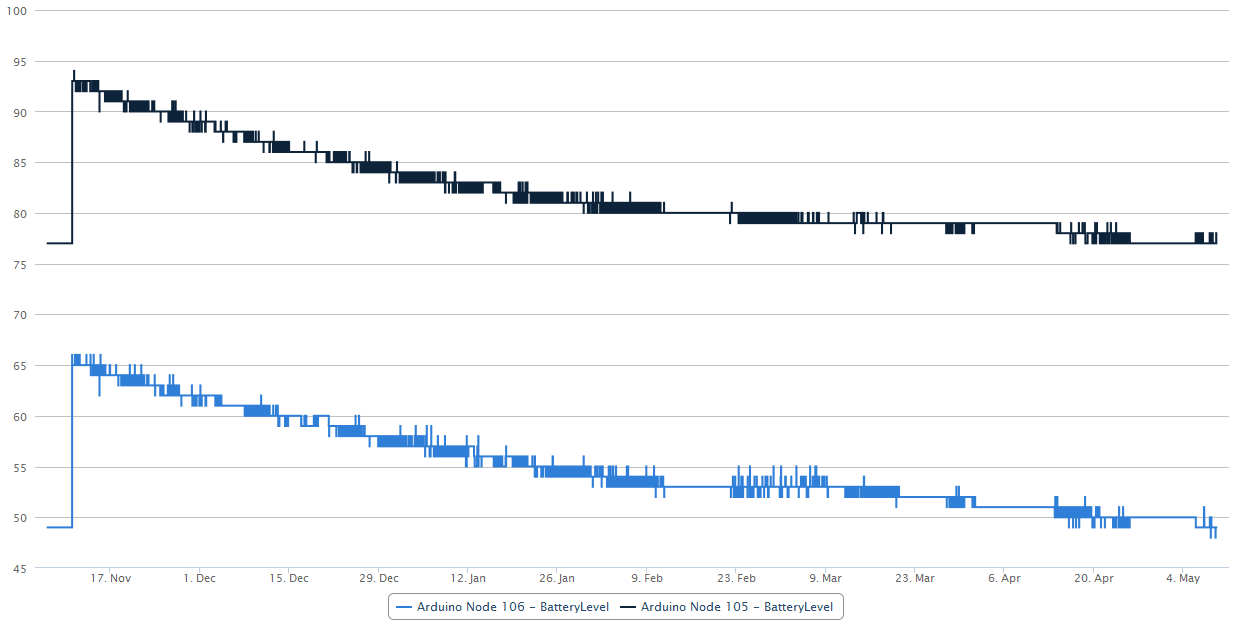
-
Hi!
This is also what im trying to do... have the same components/material as you and added the resistors for battery measurement. I dont get this long life (sleeps 15min, activated and sends).Can you post some sort of schematics or more detailed pictures so i can see your connections?
Would be great!
Here is my own try for a schematics:
http://forum.mysensors.org/uploads/upload-5ed3f6ed-2d8c-4e6e-83bf-407973550c49.jpg
-
A tip for much better batterylife: burn a new bootloader for 1mhz. Now you can attach the arduino and nrf directly to the batteries and you can measure the battery with the Internal voltage meter of the 328p. If you use a dht you attach the step-up conv. And only attach the dht to it.
-
@sundberg84
I've looked at your lovely drawing before and I don't see anything wrong with it except from that 0.1uF capacitor should be in parallell just with the 470k resistor, but it shouldn't matter regarding battery life time. What would be more interesting is to see your sketch. Or do you use the same as I do?A schematic and a few better pictures is on my to do list, but will probably come sooner now since you asked for it.
-
@m26872
Pretty much the same, i have stolen majority of your code:
Ive a array to get an average battery value each hour:#include <SPI.h> #include <MySensor.h> #include <DHT.h> //ställ in varje gång!========================= #define SketchName "Sovrum Uppe" #define SketchVer "1.0" #define NodeID 2 #define VBAT_PER_BITS 0.003363075 // Calculated volts per bit from the used battery montoring voltage divider. Internal_ref=1.1V, res=10bit=2^10-1=1023, Eg for 3V (2AA): Vin/Vb=R1/(R1+R2)=470e3/(1e6+470e3), Vlim=Vb/Vin*1.1=3.44V, Volts per bit = Vlim/1023= 0.003363075 #define VMIN 1.9 // Battery monitor lower level. Vmin_radio=1.9V #define VMAX 3.3 // " " " high level. Vmin<Vmax<=3.44 #define CHILD_ID_HUM 0 #define CHILD_ID_TEMP 1 #define HUMIDITY_SENSOR_DIGITAL_PIN 3 int BATTERY_SENSE_PIN = A0; // select the input pin for the battery sense point unsigned long SLEEP_TIME = 15*60000; //unsigned long SLEEP_TIME = 5000; //debug //Ställ även in gw.begin(,,,) //ställ in varje gång!========================= float lastTemp; float lastHum; boolean metric = true; int batteryPcnt = 0; int batLoop = 0; int batArray[3]; MySensor gw; DHT dht; MyMessage msgHum(CHILD_ID_HUM, V_HUM); MyMessage msgTemp(CHILD_ID_TEMP, V_TEMP); void setup() { // use the 1.1 V internal reference analogReference(INTERNAL); delay(500); // Allow time for radio if power used as reset <<<<<<<<<<<<<< Experimented with good result gw.begin(NULL, NodeID, false); //incomingMessageCallback - Callback function for incoming messages from other nodes or controller and request responses. Default is NULL. //nodeId - The unique id (1-254) for this sensor. Default is AUTO(255) which means sensor tries to fetch an id from controller. //repeaterMode - Activate repeater mode. This node will forward messages to other nodes in the radio network. Make sure to call process() regularly. Default in false dht.setup(HUMIDITY_SENSOR_DIGITAL_PIN); // Send the Sketch Version Information to the Gateway gw.sendSketchInfo(SketchName, SketchVer); // Register all sensors to gw (they will be created as child devices) gw.present(CHILD_ID_HUM, S_HUM); gw.present(CHILD_ID_TEMP, S_TEMP); metric = gw.getConfig().isMetric; } void loop() { int sensorValue = analogRead(BATTERY_SENSE_PIN); // Battery monitoring reading delay(1000); delay(dht.getMinimumSamplingPeriod()); float temperature = dht.getTemperature(); Serial.print("Temp: "); Serial.print(temperature); Serial.println(" C"); if (temperature > 0) { gw.send(msgTemp.set(temperature, 1)); } delay(1000); float humidity = dht.getHumidity(); Serial.print("Hum: "); Serial.print(humidity); Serial.println(" %"); if (humidity > 0) { gw.send(msgHum.set(humidity, 1)); } delay(1000); float Vbat = sensorValue * VBAT_PER_BITS; int batteryPcnt = static_cast<int>(((Vbat-VMIN)/(VMAX-VMIN))*100.); Serial.print("Battery percent: "); Serial.print(batteryPcnt); Serial.println(" %"); batArray[batLoop] = batteryPcnt; if (batLoop > 2) { batteryPcnt = (batArray[0] + batArray[1] + batArray[2] + batArray[3]); batteryPcnt = batteryPcnt / 4; Serial.print("Battery percent (Avg (4):) "); Serial.print(batteryPcnt); Serial.println(" %"); gw.sendBatteryLevel(batteryPcnt); batLoop = 0; } else { batLoop = batLoop + 1; } gw.sleep(SLEEP_TIME); //sleep a bit }
-
@Sweebee
It's already been discussed earlier in this thread (see EasyIoTs posts above), it's nevertheless a very good tip. I also have some test nodes running, but I consider it to be the next step from the "basic" design which was this threads concept. If I'll post something with this low-power-tweaked design it'll therefore be in a new thread. I should probably write something about this as an update in the first post...
-
@sundberg84
I'm no code expert, and the only thing I can think of is that your "delay(1000)" will keep the power hungry radio awake. If you need delays (apart from debug) I'd prefer sleep instead. What's your battery life time look like?
-
UPDATE
I've updated the first post with- A wiring layout.
- Added a text about the low-power option
- A few minor details.
-
Great layout/way to show your project - really nice!
Its exactly as I do it so im getting a bit jealus here... . One node is down after a week.
It might be the hardware or me not so good soldering so i short something out.I will try some more nodes now you have comfirmed I do it the right way and that should work.
@m26872
Thank you!
-
@sundberg84
Thx, good you liked it.
With such fast battery drain it should be easier to trace the current draw. First you'll need to measure the current. Second option is of course the good old switch-and-replace troubleshooting method.
I've read about hardware and quality issues, but let's hope it isn't...
-
@m26872 What kind of pro-mini do you use?
Im using deek robot 3.3v 8mhz and it seems like there is a problem with this: (http://forum.mysensors.org/topic/230/power-conservation-with-battery-powered-sensors) i kill them when i try to remove voltage regulator so i guess i havent suceeded yet with that.I dont have any good equipment to measure current... Ill have made a new sensor today - lets see how it operates.
-
Here are some close-up pictures of my Node 105 (which I opened with maximum care not to spoil my long term testing)
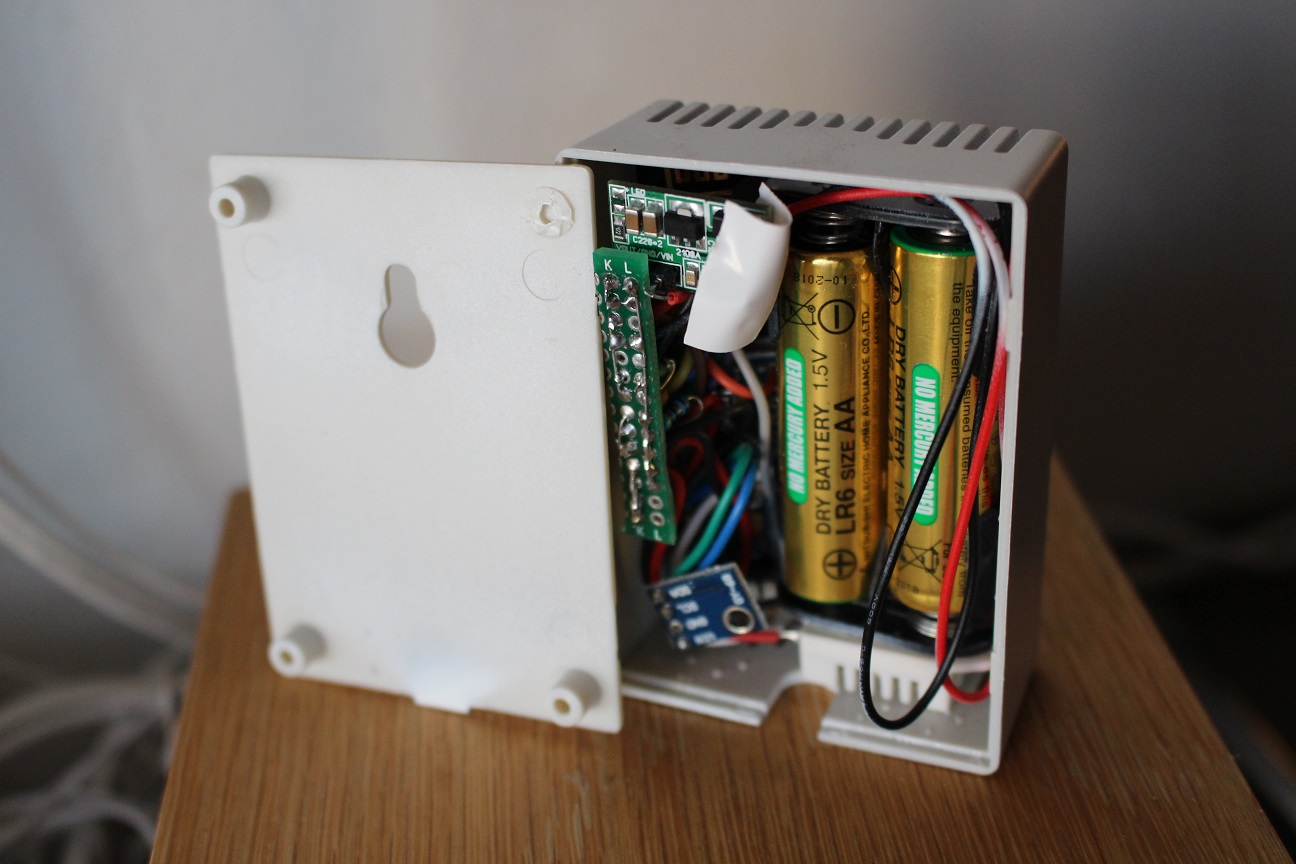
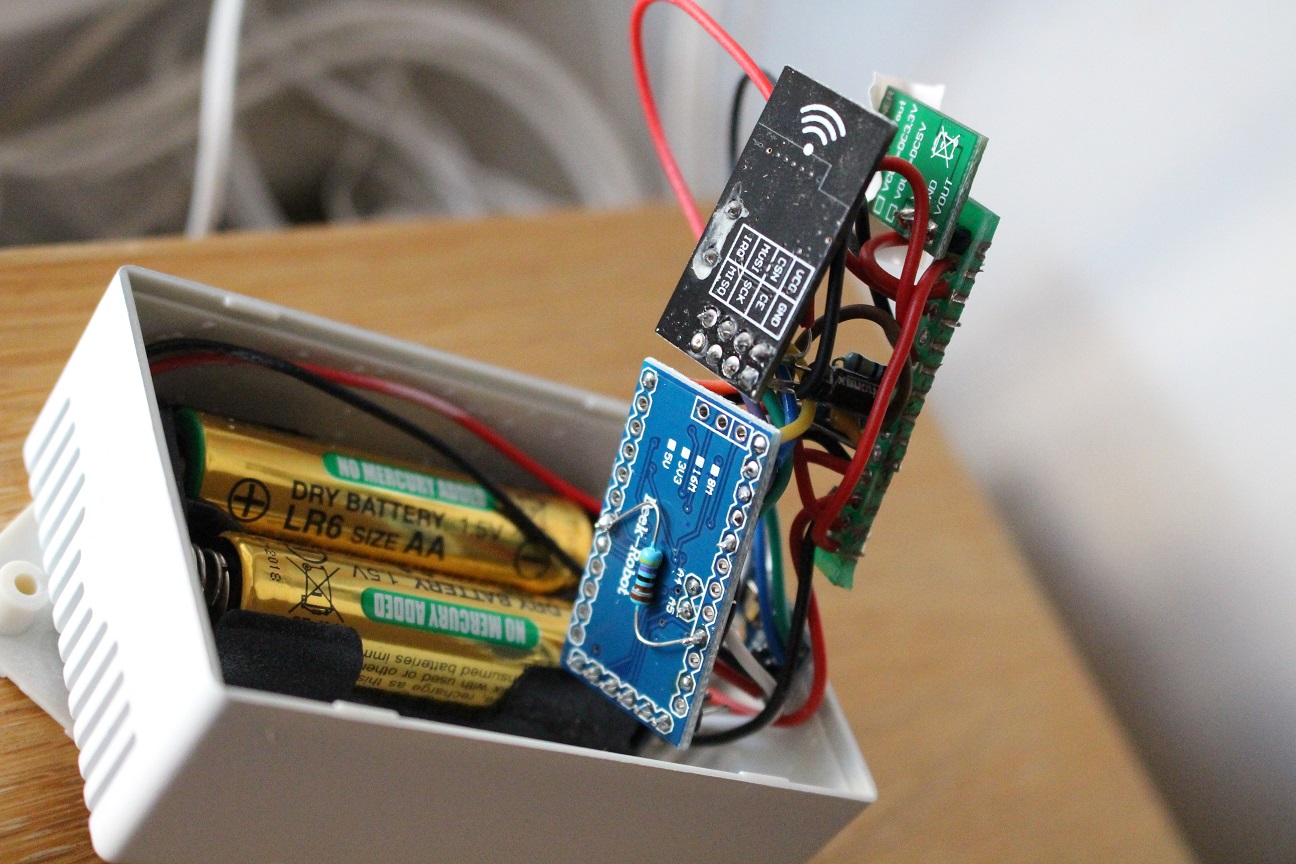
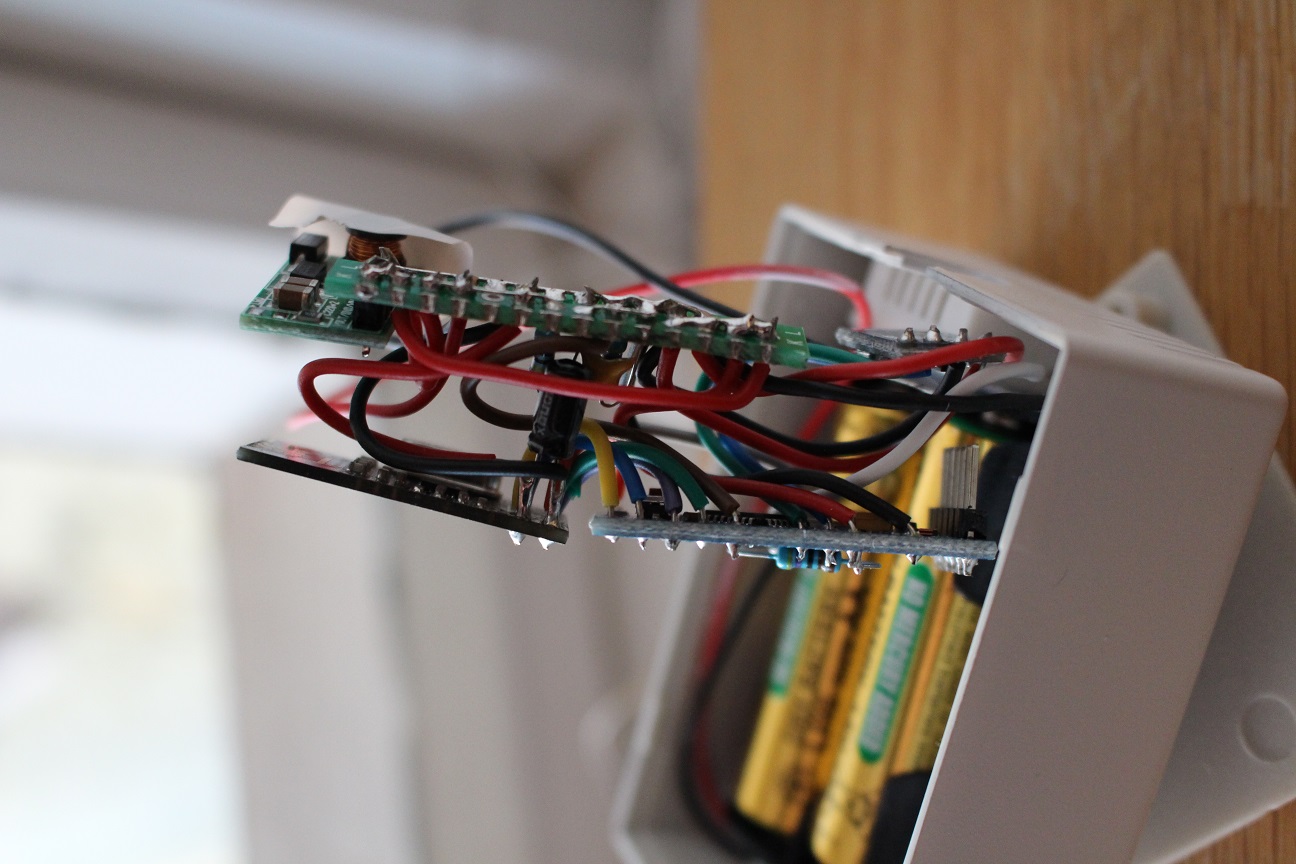
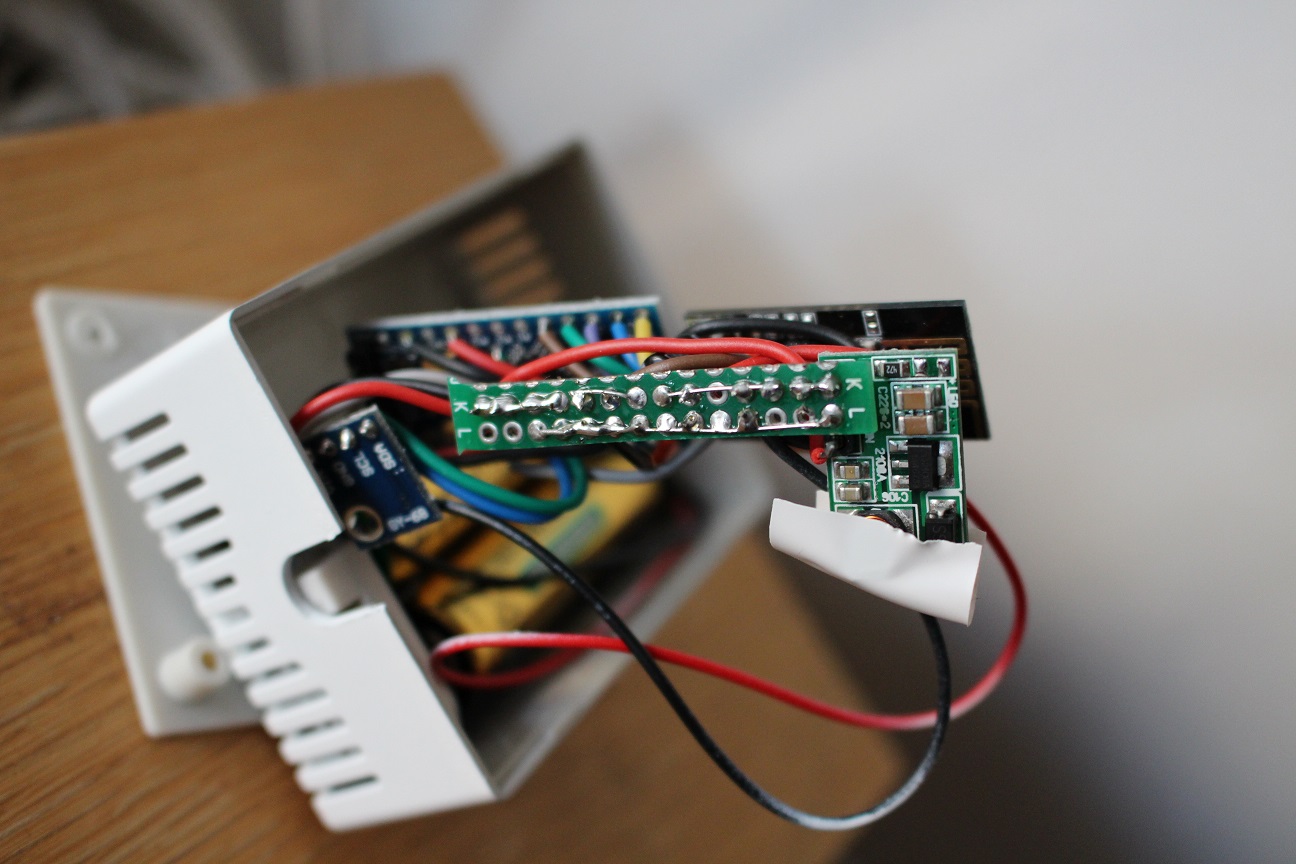
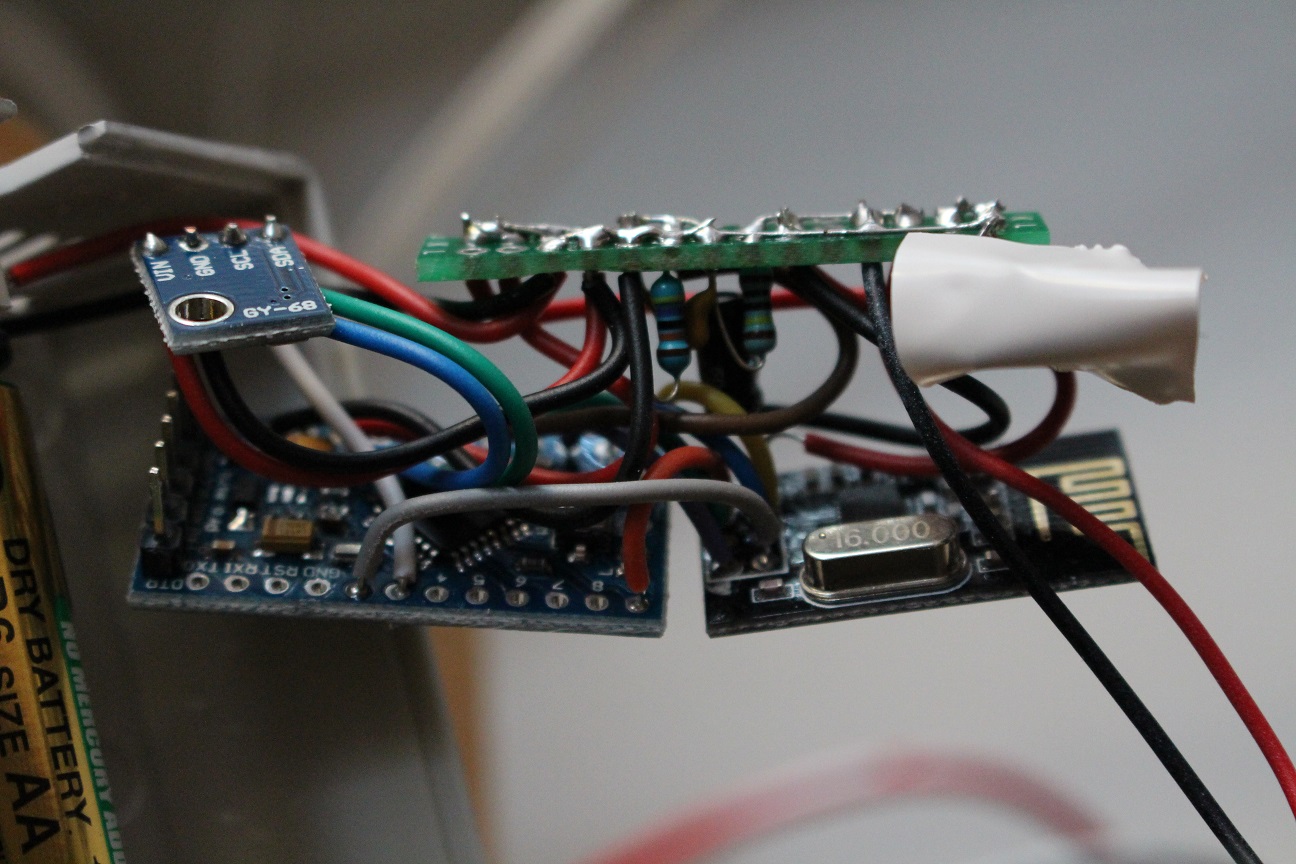
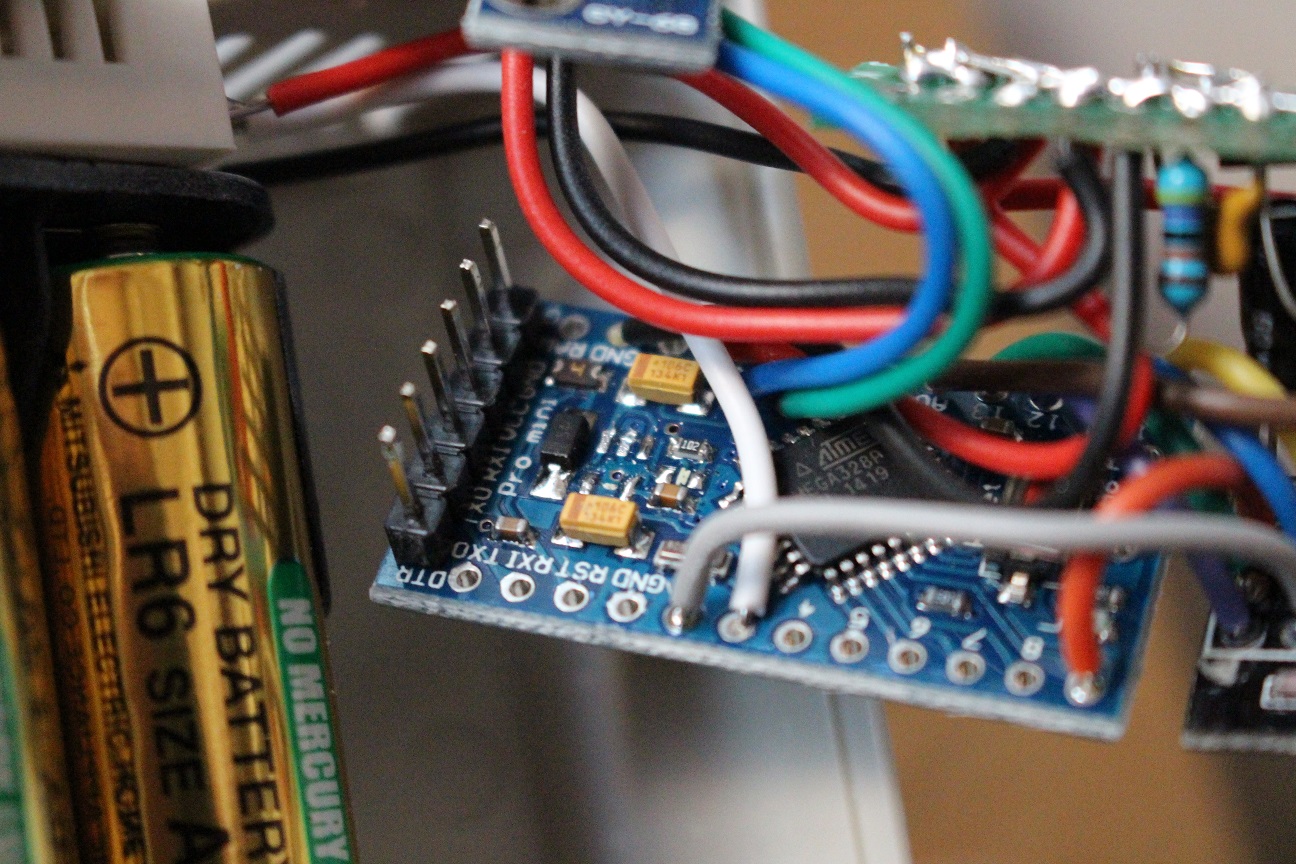

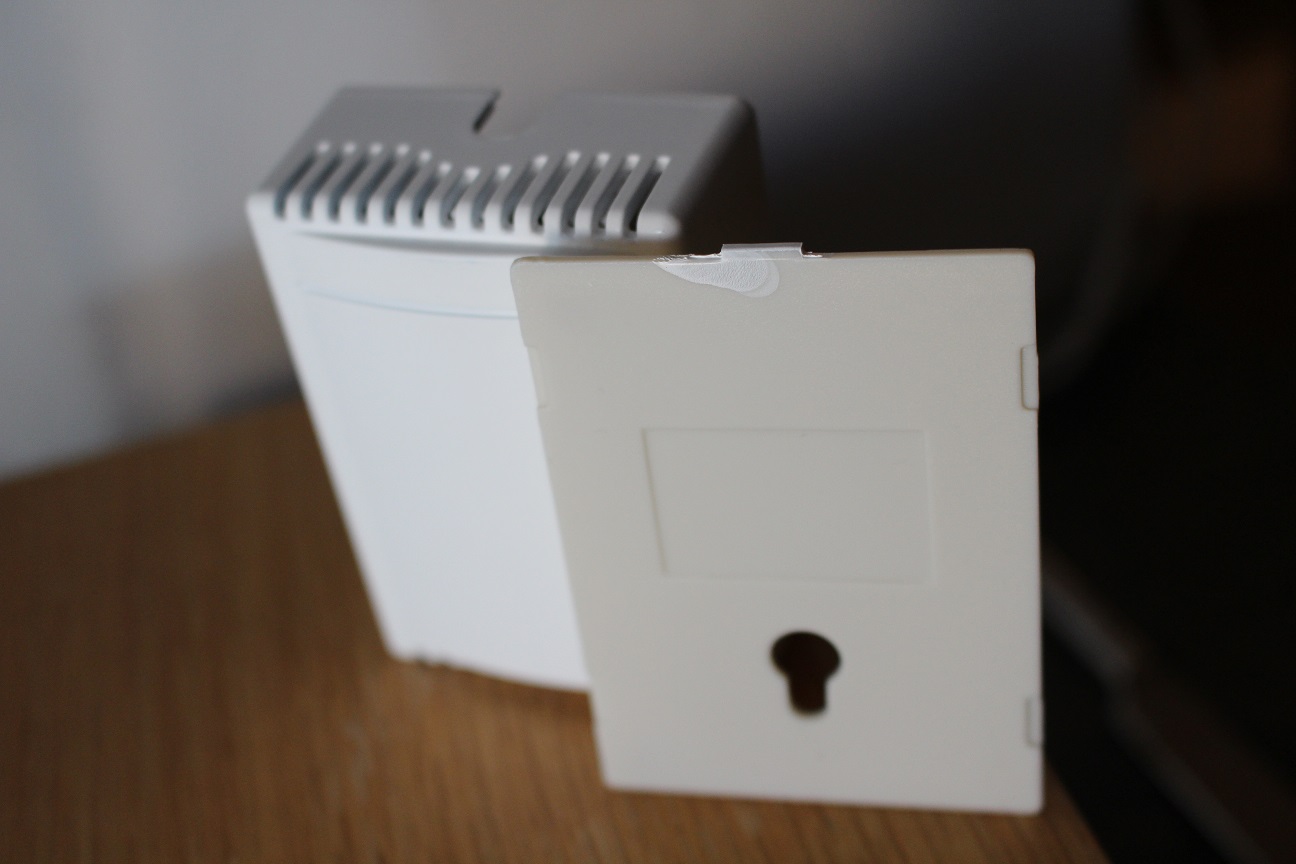
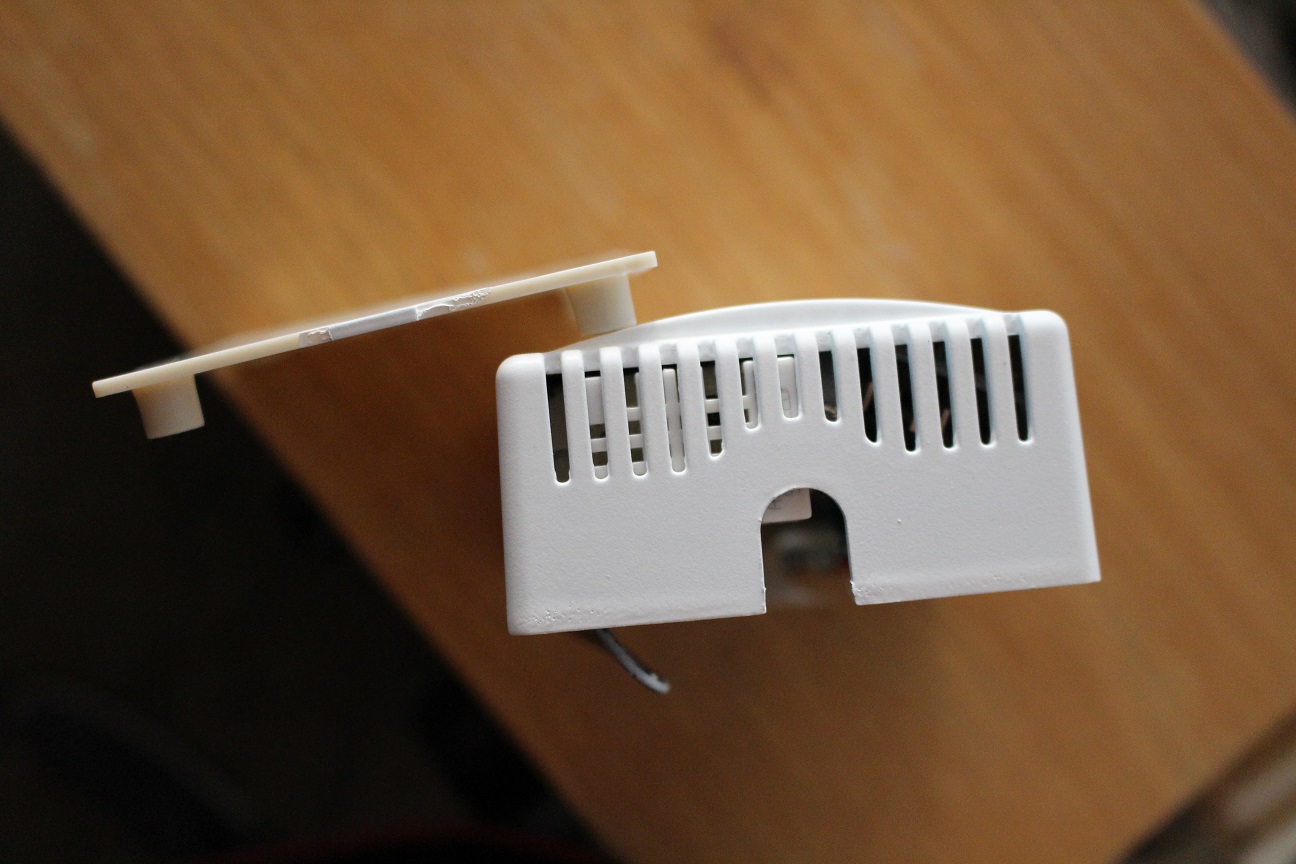
-
Node 105 starts to become famous here

We all follow him(?) with great excitement.
-
yes, @m26872 any news ?
-
The news is that my Vera Lite gave up (soft-wise) after all hacking, plug-ins and un-clean factory resets, so I gave up on her (and Z-wave too, at least for a while). We've been fighting with each other for too long, so I'd say the divorce was welcome.
Instead, in the controller jungle I decided to try Fhem, aware of the challanges as I'm not German- (nor Perl) speaking. I'm still in the sens-but-no-control-phase and have a few test nodes running, including "the" node 105. (Very easy transition btw, just one press at reset button then a node is in production with a new controller.)
Back home today after 2w holiday I think it's looking good. The only problem now is of course that my trending is broken. If anyone knows how to merge the old trend data with the new, you're very welcome? Or just on how to rescue the Datamine data (from NAS)? If possible? I haven't researched anything yet.

-
Just an idea... I'm not sure if someone mentioned it:
If sending consumes so much power... what about collecting sensor data every 5 minutes and then send the data (array) once per hour? Of course there would be some time calculating before logging in the controller (fhem), but this way, I can save power... What do you think?
-
@Meister_Petz Kind of what I already do in the test nodes 105/106 if you look at code above. Update frequencey and battery life time is a balance that can be adjusted just as you wish. Right now these node send update every 15 min and take sample for calculation 5 min before, which is about what I need. If you and your application is more interested in trending, history and data collection, I think your suggestion is excellent. If you need a fast response or action from your automation system it's not.
But, what I think is most unneseccary with my test nodes 105/106 is that they check battery level every 15 min and send update if it has changed. Since the level typically is unstable right after the first transmission, it will generate a lot of useless transmissions. The only reason for me not to update code in node 105/106 is to keep it as an untouched study case. In my new nodes I usually set a fixed battery check/update frequency (1/week) which also works as a heartbeat signal for less active nodes.
-
Not sure if any one has had the same question. But the other day I stumbled on this little thing

https://www.adafruit.com/product/1572 It's a really small rechargeable battery. Now I don't no much about batteries. But I know that my LiOn powerd handdrill is very strong. The batteries of my handdril hardly lose power over time.So I was wondering if this could be used to power an Arduino and some sensors and how long it will take for the battery te become empty. It would make my 3.3V Sensors really small. I could almost install them in a small matchbox. Which I think is really cool!
-
@TheoL There are endless discussions about different batteries in the forum. Just search and read. I recall one issue with LiXx batteries is that max voltage is too high for the NRF24L01+ radio.
-
Ok, another thing: why not sending everything at once?
As I understand you are using FHEM which allows a lot of coding on the controller side. So you could send batteryLevel, humidity and temperature in one go.
Something like (this is no real code, just an idea):
theValues = "battlvl:hum:temp"
gw.send(msgAll.set(theValues, 1));and in fhem you split it at ":"
So you have just one instead of 3 transmits.
-
@Meister_Petz I think it's a very good idea! It would be a nice option to have. Parsing with Perl should be simple even for a beginner like me, but to change the Mysensors core and fhem plugin is far beyond what I can. If you can do it, just go ahead and plz share.
-
ok, I did some testing and succeeded:
This is the important part of the Arduino code:
String allSens = String(sensor1) + " " + String(sensor2); gw.send(msg1.set(allSens.c_str()));This is the FHEM code:
define Sensor MYSENSORS_DEVICE 20 attr Sensor IODev MSGateway attr Sensor mapReading_brightness1 1 brightness attr Sensor mode node attr Sensor version 1.5 attr Sensor userReadings Bat Deg # split and copy to userReadings define Sensor.copy at +*00:02:00 {my $a = ReadingsVal("Sensor","brightness1",1);; my @b = split(/\ /,$a);; fhem("setreading Sensor Bat $b[0]");; fhem("setreading Sensor Grad $b[1]");;}P.S.: when I had this in fhem.cfg I had to use @@ instead of only one @
This is my complete Arduino code for a Battery Sensor with Dallas Temp:
#include <MySensor.h> #include <SPI.h> #define SketchName "Sensor-send-all" #define SketchVer "1.2" #define NodeID 20 unsigned long SleepTime = 828523; // 55234 = 1 Minute --- 828523 = 15 Minuten MySensor gw; // this is the one which sends everything #define SENSOR1_ID 1 // Sensor 1 - allAtOnceMessage //------------------------------------------------ // Sensor PINS #define SENSOR1_PIN A0 // BattLevel #define SENSOR2_PIN 6 // Dallas // MyMessage V_TEMP, V_LIGHT_LEVEL, ... depending on Sensor Type MyMessage msg1(SENSOR1_ID,V_LIGHT_LEVEL); // Sensor 5 - allAtOnceMessage //------------------------------------------------ // Dallas Temp #include <OneWire.h> #include <DallasTemperature.h> OneWire oneWire(SENSOR2_PIN); DallasTemperature sensors(&oneWire); boolean receivedConfig = false; float firstRun = 1; boolean metric = true; void setup() { // use the 1.1 V internal reference analogReference(INTERNAL); delay(500); // Allow time for radio if power used as reset <<<<<<<<<<<<<< Experimented with good result gw.begin(NULL, NodeID, false); // Send the sketch version information to the gateway and Controller gw.sendSketchInfo(SketchName, SketchVer); // present all Sensors to Gateway - S_TEMP, S_LIGHT_LEVEL,... depending an SENSOR type gw.present(SENSOR1_ID, S_LIGHT_LEVEL); sensors.begin(); } void loop() { gw.process(); // wait some time to get all parts powered up if (firstRun == 1){ delay(5000); firstRun = 0; } else { delay(1000); } //---------------------- // Sensor1 - Battery Voltage - Part 1 int sensorRead10 = analogRead(SENSOR1_PIN); //---------------------- // Sensor2 - DAL sensors.requestTemperatures(); int16_t conversionTime = sensors.millisToWaitForConversion(sensors.getResolution()); gw.sleep(conversionTime); float sensorRead2 = static_cast<float>(static_cast<int>((metric?sensors.getTempCByIndex(0):sensors.getTempFByIndex(0)) * 10.)) / 10.; //---------------------- // Sensor1 - Battery Voltage - Part 2 int sensorRead11 = analogRead(SENSOR1_PIN); //Volt der Battery float sensorRead1 = (sensorRead10 + sensorRead11 + sensorRead12) / 3 * 0.0033; // should be 0.003363075 my Batteries are different float test = sensorRead10; //---------------------- // send all to fhem String allComb = String(sensorRead1) + " " + String(sensorRead2); gw.send(msg1.set(allComb.c_str())); gw.sleep(SleepTime); }
-
@Meister_Petz Wow! Well done! I think this can be very useful.
In theory some power should be saved. Estimation from here is that a 250kbit/s transmission of a maximum size (32 byte) packet is >1.5ms. I think at around 20mA. Massage header is 7 byte, but a normal massage just a few bytes, i.e. just 30% of a message. Startup time for radio is fast (140us), so that shouldn't be an issue. (A side note here is that wake up atmega328p from sleep takes long (6ms?).)Is there a reason that you wrote the Fhem sonsor.copy macro as an "at" and not a "notify" ? The intuitive way would be to copy upon a new reading.
-
@m26872 there is no special reason for "at"... I think I got it from some where and it worked

-
Soon 11 months of production including a fair amount of too frequent battery uppdates. Most exciting is wheter the initially used batteries in 106 will make it 12 months or not.


-
@m26872 perhaps you could reduce the redundant updates by filtering. If the current sample is lower than the "next" sample ignore it. If your node does not support charging, it will never really truly read an increase in battery voltage.
-
@Anticimex Yes, but in this particular case its double. Conclusion from above was that frequency and magnitude of the "low spikes" gives you information of how near the end you are. On the other hand I would never run like this if it wasn't for keeping the experiment "untouched". I think my thought for future sensors is to preserve that information, but save battery, just by reducing the number of samples.
I'm still not sure of the best filter/algorithm to predict battery end of life from present and historic data. It will probably differ a lot wheter there's a step-up or a nicer load.
-
@m26872 Just a suggestion: once the node dies you could take the raw data and run some filtering on it like @Anticimex suggested.
It'll give you a quick way to experiment with different filter settings.
Once you find an optimal filter you can implement it in the node(s).
-
@Yveaux You're right. I expect a good correlation between "spike depth" and the load profile just prior to sample. By controling this it should be quite repeatable.
-
This post is deleted!
-
@mntlvr Interesting discussion but why in this thread?
-
This post is deleted!
-
i think it would be better to open a new thread for this, instead to discuss two topics in one thread....the 2xaa battery sensor is very interesting

-
The 12 months target was done a few days ago. Today's status 105: 63% and 106: 27%
I had a thought to celebrate their birthday by retrieve old Vera data and make nice plot, but that has to wait. Next, 18 months.Just to clarify that these are no "sleeping" nodes; they transmit 100-150 messages each every day.
-
Battery level status report after 18 months:
Node 105: 51%
Node 106 (with used batteries): Died early January.Next 24 months.
-
Hey @m26872 Congrats on the testing and results! Looks great! I was wondering if I could get your feedback on something. I'm trying to build a very low powered ( 2 x AA ) Battery powered 3 in 1 sensor. ( Platform is a Pro Mini 8Mhz, 3.3v, with an PIR HC-SR501, NRF24L01, and a DHT 11 Temp and Hum sensor. The sensor should also report battery power periodically ideally using the vcc library ( not implemented yet ). Because these components use power hungry devices ( PIR, DHT ), I have already moded the PIR to work at 3.3, and have removed the regulator / LED from the pro mini. Would it make sense to use a step up / down regulator, or power directly from the VCC pin? I can't decide what would be more effective in prolonging battery life? Also, in terms of reporting battery state. I'm not sure what would be best also, hence the question around the VCC library?
Below is my sketch. It is really taken from various posts on this forum and stitched together. If you could have a peak at it, and see if it is "optimal", as I don't believe it is today. ie: Perhaps I could only report temp / hum if it changes +/- a degree? Or send everything in a single radio announcement, then "Deep Sleep"? Lots of questions, and of course I am sure there are lots of answers. I'm just trying to build the most optimal battery efficient ( 2 x AA ) powered sensor no problem right!
 Below is my current code:
Below is my current code:#define MY_GW_ID 31 // Enable debug prints #define MY_DEBUG // Enable and select radio type attached #define MY_RADIO_NRF24 //#define MY_RADIO_RFM69 #include <SPI.h> #include <MySensor.h> #include <DHT.h> int BATTERY_SENSE_PIN = A0; // select the input pin for the battery sense point //Constants #define SKETCH_NAME "3 in 1 Sensor" #define SKETCH_VERSION "1.0" #define CHILD_ID_HUM 0 // Child id for Humidity #define CHILD_ID_TEMP 1 // Child id for Temperature #define CHILD_ID_MOT 2 // Id of the sensor child #define HUMIDITY_SENSOR_DIGITAL_PIN 7 // Where is my DHT22 data pin connected to #define DIGITAL_INPUT_SENSOR 3 // The digital input you attached your motion sensor. (Only 2 and 3 generates interrupt!) #define INTERRUPT DIGITAL_INPUT_SENSOR-2 // Usually the interrupt = pin -2 (on uno/nano anyway) //Misc. variables uint8_t switchState = 2; unsigned long SLEEP_TIME = 820000; // Sleep time between reads (in milliseconds) (close to 15') unsigned long SLEEP_TIME2 = 275000; // Sleep time after int. (in milliseconds) (close to 5') uint8_t cycleInProgress = 0; uint8_t firstReportDone = 0; uint8_t firstReportWithZeroDone = 0; int oldBatteryPcnt = 0; MySensor gw; DHT dht; float lastTemp = 0 ; float lastHum = 0 ; boolean lastTripped = false ; boolean metric = true; MyMessage msgHum(CHILD_ID_HUM, V_HUM); MyMessage msgTemp(CHILD_ID_TEMP, V_TEMP); MyMessage msgMot(CHILD_ID_MOT, V_TRIPPED); void setup() { // use the 1.1 V internal reference #if defined(__AVR_ATmega2560__) analogReference(INTERNAL1V1); #else analogReference(INTERNAL); #endif gw.begin(); dht.setup(HUMIDITY_SENSOR_DIGITAL_PIN); // Send the Sketch Version Information to the Gateway gw.sendSketchInfo("3 in 1 Sensor", "1.0"); pinMode(DIGITAL_INPUT_SENSOR, INPUT); // sets the motion sensor digital pin as input // Register all sensors to gw (they will be created as child devices) gw.present(CHILD_ID_HUM, S_HUM); gw.present(CHILD_ID_TEMP, S_TEMP); gw.present(CHILD_ID_MOT, S_MOTION); metric = gw.getConfig().isMetric; } void loop() { delay(dht.getMinimumSamplingPeriod()); float temperature = dht.getTemperature(); float humidity = dht.getHumidity(); if (isnan(temperature)) { Serial.println("Failed reading temperature from DHT"); } else if (temperature != lastTemp) { lastTemp = temperature; if (!metric) { temperature = dht.toFahrenheit(temperature); } gw.send(msgTemp.set(temperature, 1)); Serial.print("T: "); Serial.println(temperature); } if (isnan(humidity)) { Serial.println("Failed reading humidity from DHT"); } else if (humidity != lastHum) { lastHum = humidity; gw.send(msgHum.set(humidity, 1)); Serial.print("H: "); Serial.println(humidity); } // get the battery Voltage int sensorValue = analogRead(BATTERY_SENSE_PIN); #ifdef DEBUG Serial.println(sensorValue); #endif // 1M, 470K divider across battery and using internal ADC ref of 1.1V // Sense point is bypassed with 0.1 uF cap to reduce noise at that point // ((1e6+470e3)/470e3)*1.1 = Vmax = 3.44 Volts // 3.44/1023 = Volts per bit = 0.003363075 float batteryV = sensorValue * 0.003363075; int batteryPcnt = sensorValue / 10; #ifdef DEBUG Serial.print("Battery Voltage: "); Serial.print(batteryV); Serial.println(" V"); Serial.print("Battery percent: "); Serial.print(batteryPcnt); Serial.println(" %"); #endif // Read digital motion value boolean tripped = digitalRead(DIGITAL_INPUT_SENSOR) == HIGH; if (tripped != lastTripped ) { Serial.println(tripped); gw.send(msgMot.set(tripped?"1":"0")); // Send tripped value to gw } if (oldBatteryPcnt != batteryPcnt) { // Power up radio after sleep gw.sendBatteryLevel(batteryPcnt); oldBatteryPcnt = batteryPcnt; } // Sleep until interrupt comes in on motion sensor. Send update every two minute. gw.sleep(INTERRUPT, CHANGE, 0 ); }thanks very much!
-
@rhuehn It looks like you are repeating the conversation in this thread. Its better to continue the discussion there.
-
I agree with AWI, but would like to add one thing: By using the DHT11 you are really fighting an uphill battle. There are several sensors that are more suitable for battery-powered sensors. See the study referenced by @AWI in https://forum.mysensors.org/topic/3801/witch-temp-hum-sensor-is-best-to-use-for-battery-powered-sensors/2
-
Thanks @mfalkvidd Starting to realize that..... I might swap to the HTU21D, but keep in mind I'm also using a PIR..... Is there a reliable, low voltage PIR sensor that works well? I haven't seen one yet ( 2 x AA BATT's, under 2.8 V )?
Thanks
-
I have updated the original post if anyone can offer any suggestions. it is located Here
Any feedback is greatly appreciated
-
@EasyIoT , how are your sensors doing, its been 2 years

And also, @m26872 , the node 105. Is it alive?
-
@Nicklas-Starkel I've been busy for few months moving to a new house and have had my sensor network offline until now because of this. Node 105 was kept on and handled with care, but I was pretty sure it would be dead when I started my gateway yesterday. BUT, it was ALIVE ?! at 14% battery level. Amazing! 24 months with such poor and simple hardware and software.






 Same batteries and only one restart (due to my controller change last year).
Same batteries and only one restart (due to my controller change last year).
One little remark though, it doesn't seem to send temperature och pressure, only humidity and battery level. Maybe an issue of voltage recovery time between transmissions.
-
This post is deleted!
-
Sorry for the noob question...
I would re-create your setup. At which point of it you insert the multimeter to measure the current?Is it ok to "interrupt" the ground (proximity to the step up) and measure the current there?
Thank you
-
@sineverba Just cut one of the battery wires of the finished assembly. Solder together again when your done measuring.
-
Has anyone got a V2 version working for this?
-
@palmerfarmer said in My 2AA battery sensor:
Has anyone got a V2 version working for this?
Do you mean running with MySensors 2.3?
-
Any Ver 2.xx,
So I have cobbled together/hacked this and it seem to work, battery has stayed at 97% for 2 weeks now. Feel free to Hack about and improve i have this mounted on an easyPCB board, x2AA batteries, NRF radio, BME280 with a 3.3v convertor ./* * use mysensors library 2.2.0 * ALL WORKING AND TESTED ON EASY PCB BOARD WITH BATTERY SAVING CODE 29/11/18 * * Time SET to 15 mins * also added BME280.writeMode (smSleep); to reduce quisecent to current to 40uA * BME280 sensor connections: 3.3v, 0V, SCL to A5, SDA to A4, BAT to A0 **/ //Enable debug prints to serial monitor #define MY_DEBUG // Enable and select radio type attached #define MY_RADIO_NRF24 #define MY_RF24_PA_LEVEL RF24_PA_MIN //settings are MIN, LOW, HIGH, MAX #define MY_NODE_ID 18 //#define MY_RADIO_RFM69 #include <SPI.h> #include <MySensors.h> #include <Wire.h> #include <BME280_MOD-1022.h> // BME280 libraries and variables // Bosch BME280 Embedded Adventures MOD-1022 weather multi-sensor Arduino code // Written originally by Embedded Adventures // https://github.com/embeddedadventures/BME280 #define BARO_CHILD 0 #define TEMP_CHILD 1 #define HUM_CHILD 2 int BATTERY_SENSE_PIN = A0; // select the input pin for the battery sense point unsigned long SLEEP_TIME = 15*60000; // sleep time between reads (seconds x*1000 milliseconds) //unsigned long SLEEP_TIME = 20000; // Debug test time 20 seconds int oldBatteryPcnt = 0; long interval = 1000; // 1 min interval at which to send (milliseconds) long previousMillis = interval; // will store last time data was sent const float ALTITUDE = 0; // <-- adapt this value to your location's altitude (in m). Use your smartphone GPS to get an accurate value! const char *weather[] = { "stable", "sunny", "cloudy", "unstable", "thunderstorm", "unknown" }; enum FORECAST { STABLE = 0, // "Stable Weather Pattern" SUNNY = 1, // "Slowly rising Good Weather", "Clear/Sunny " CLOUDY = 2, // "Slowly falling L-Pressure ", "Cloudy/Rain " UNSTABLE = 3, // "Quickly rising H-Press", "Not Stable" THUNDERSTORM = 4, // "Quickly falling L-Press", "Thunderstorm" UNKNOWN = 5 // "Unknown (More Time needed) }; const int LAST_SAMPLES_COUNT = 5; float lastPressureSamples[LAST_SAMPLES_COUNT]; // this CONVERSION_FACTOR is used to convert from Pa to kPa in the forecast algorithm // get kPa/h by dividing hPa by 10 #define CONVERSION_FACTOR (1.0/10.0) int minuteCount = 0; bool firstRound = true; // average value is used in forecast algorithm. float pressureAvg; // average after 2 hours is used as reference value for the next iteration. float pressureAvg2; float dP_dt; boolean metric; MyMessage tempMsg(TEMP_CHILD, V_TEMP); MyMessage humMsg(HUM_CHILD, V_HUM); MyMessage pressureMsg(BARO_CHILD, V_PRESSURE); float getLastPressureSamplesAverage() { float lastPressureSamplesAverage = 0; for (int i = 0; i < LAST_SAMPLES_COUNT; i++) { lastPressureSamplesAverage += lastPressureSamples[i]; } lastPressureSamplesAverage /= LAST_SAMPLES_COUNT; return lastPressureSamplesAverage; } // Algorithm found here // http://www.freescale.com/files/sensors/doc/app_note/AN3914.pdf // Pressure in hPa --> forecast done by calculating kPa/h int sample(float pressure) { // Calculate the average of the last n minutes. int index = minuteCount % LAST_SAMPLES_COUNT; lastPressureSamples[index] = pressure; minuteCount++; if (minuteCount > 185) { minuteCount = 6; } if (minuteCount == 5) { pressureAvg = getLastPressureSamplesAverage(); } else if (minuteCount == 35) { float lastPressureAvg = getLastPressureSamplesAverage(); float change = (lastPressureAvg - pressureAvg) * CONVERSION_FACTOR; if (firstRound) // first time initial 3 hour { dP_dt = change * 2; // note this is for t = 0.5hour } else { dP_dt = change / 1.5; // divide by 1.5 as this is the difference in time from 0 value. } } else if (minuteCount == 65) { float lastPressureAvg = getLastPressureSamplesAverage(); float change = (lastPressureAvg - pressureAvg) * CONVERSION_FACTOR; if (firstRound) //first time initial 3 hour { dP_dt = change; //note this is for t = 1 hour } else { dP_dt = change / 2; //divide by 2 as this is the difference in time from 0 value } } else if (minuteCount == 95) { float lastPressureAvg = getLastPressureSamplesAverage(); float change = (lastPressureAvg - pressureAvg) * CONVERSION_FACTOR; if (firstRound) // first time initial 3 hour { dP_dt = change / 1.5; // note this is for t = 1.5 hour } else { dP_dt = change / 2.5; // divide by 2.5 as this is the difference in time from 0 value } } else if (minuteCount == 125) { float lastPressureAvg = getLastPressureSamplesAverage(); pressureAvg2 = lastPressureAvg; // store for later use. float change = (lastPressureAvg - pressureAvg) * CONVERSION_FACTOR; if (firstRound) // first time initial 3 hour { dP_dt = change / 2; // note this is for t = 2 hour } else { dP_dt = change / 3; // divide by 3 as this is the difference in time from 0 value } } else if (minuteCount == 155) { float lastPressureAvg = getLastPressureSamplesAverage(); float change = (lastPressureAvg - pressureAvg) * CONVERSION_FACTOR; if (firstRound) // first time initial 3 hour { dP_dt = change / 2.5; // note this is for t = 2.5 hour } else { dP_dt = change / 3.5; // divide by 3.5 as this is the difference in time from 0 value } } else if (minuteCount == 185) { float lastPressureAvg = getLastPressureSamplesAverage(); float change = (lastPressureAvg - pressureAvg) * CONVERSION_FACTOR; if (firstRound) // first time initial 3 hour { dP_dt = change / 3; // note this is for t = 3 hour } else { dP_dt = change / 4; // divide by 4 as this is the difference in time from 0 value } pressureAvg = pressureAvg2; // Equating the pressure at 0 to the pressure at 2 hour after 3 hours have past. firstRound = false; // flag to let you know that this is on the past 3 hour mark. Initialized to 0 outside main loop. } int forecast = UNKNOWN; if (minuteCount < 35 && firstRound) //if time is less than 35 min on the first 3 hour interval. { forecast = UNKNOWN; } else if (dP_dt < (-0.25)) { forecast = THUNDERSTORM; } else if (dP_dt > 0.25) { forecast = UNSTABLE; } else if ((dP_dt > (-0.25)) && (dP_dt < (-0.05))) { forecast = CLOUDY; } else if ((dP_dt > 0.05) && (dP_dt < 0.25)) { forecast = SUNNY; } else if ((dP_dt >(-0.05)) && (dP_dt < 0.05)) { forecast = STABLE; } else { forecast = UNKNOWN; } return forecast; } void setup() { // use the 1.1 V internal reference #if defined(__AVR_ATmega2560__) analogReference(INTERNAL1V1); #else analogReference(INTERNAL); #endif metric = getControllerConfig().isMetric; // was getConfig().isMetric; before MySensors v2.1.1 Wire.begin(); // Wire.begin(sda, scl) // use the 1.1 V internal reference #if defined(__AVR_ATmega2560__) analogReference(INTERNAL1V1); #else analogReference(INTERNAL); #endif } void presentation() { // Send the sketch version information to the gateway and Controller sendSketchInfo("BME280_BAT_V2", "V2e."); // Register sensors to gw (they will be created as child devices) present(BARO_CHILD, S_BARO); present(TEMP_CHILD, S_TEMP); present(HUM_CHILD, S_HUM); } // Loop void loop() { { // get the battery Voltage int sensorValue = analogRead(BATTERY_SENSE_PIN); #ifdef MY_DEBUG Serial.println(sensorValue); #endif // 1M, 470K divider across battery and using internal ADC ref of 1.1V // Sense point is bypassed with 0.1 uF cap to reduce noise at that point // ((1e6+470e3)/470e3)*1.1 = Vmax = 3.44 Volts // 3.44/1023 = Volts per bit = 0.003363075 int batteryPcnt = sensorValue / 10; #ifdef MY_DEBUG float batteryV = sensorValue * 0.003363075; Serial.print("Battery Voltage: "); Serial.print(batteryV); Serial.println(" V"); Serial.print("Battery percent: "); Serial.print(batteryPcnt); Serial.println(" %"); #endif if (oldBatteryPcnt != batteryPcnt) { // Power up radio after sleep sendBatteryLevel(batteryPcnt); oldBatteryPcnt = batteryPcnt; } // sleep(SLEEP_TIME); } unsigned long currentMillis = millis(); if(currentMillis - previousMillis > interval) { // save the last time sent the data previousMillis = currentMillis; analogReference(INTERNAL); wait(500); // need to read the NVM compensation parameters BME280.readCompensationParams(); // Normal mode for regular automatic samples BME280.writeStandbyTime(tsb_0p5ms); // tsb = 0.5ms BME280.writeFilterCoefficient(fc_16); // IIR Filter coefficient 16 BME280.writeOversamplingPressure(os16x); // pressure x16 BME280.writeOversamplingTemperature(os8x); // temperature x8 BME280.writeOversamplingHumidity(os8x); // humidity x8 BME280.writeMode(smNormal); // Just to be sure, wait until sensor is done mesuring while (BME280.isMeasuring()) { } // Read out the data - must do this before calling the getxxxxx routines BME280.readMeasurements(); float temperature = BME280.getTemperatureMostAccurate(); // must get temp first float humidity = BME280.getHumidityMostAccurate(); float pressure_local = BME280.getPressureMostAccurate(); // Get pressure at current location float pressure = pressure_local/pow((1.0 - ( ALTITUDE / 44330.0 )), 5.255); // Adjust to sea level pressure using user altitude int forecast = sample(pressure); if (!metric) { // Convert to fahrenheit temperature = temperature * 9.0 / 5.0 + 32.0; } //**/ Serial.println(); Serial.print("Temperature = "); Serial.print(temperature); Serial.println(metric ? " °C" : " °F"); Serial.print("Humidity = "); Serial.print(humidity); Serial.println(" %"); Serial.print("Pressure = "); Serial.print(pressure); Serial.println(" hPa"); Serial.print("Forecast = "); Serial.println(weather[forecast]); Serial.println(); //*/ send(tempMsg.set(temperature, 1)); wait(50); send(humMsg.set(humidity, 1)); wait(50); send(pressureMsg.set(pressure, 2)); wait(50); BME280.writeMode (smSleep); sleep(SLEEP_TIME); } }
-
11months on battery at 87%... still working!
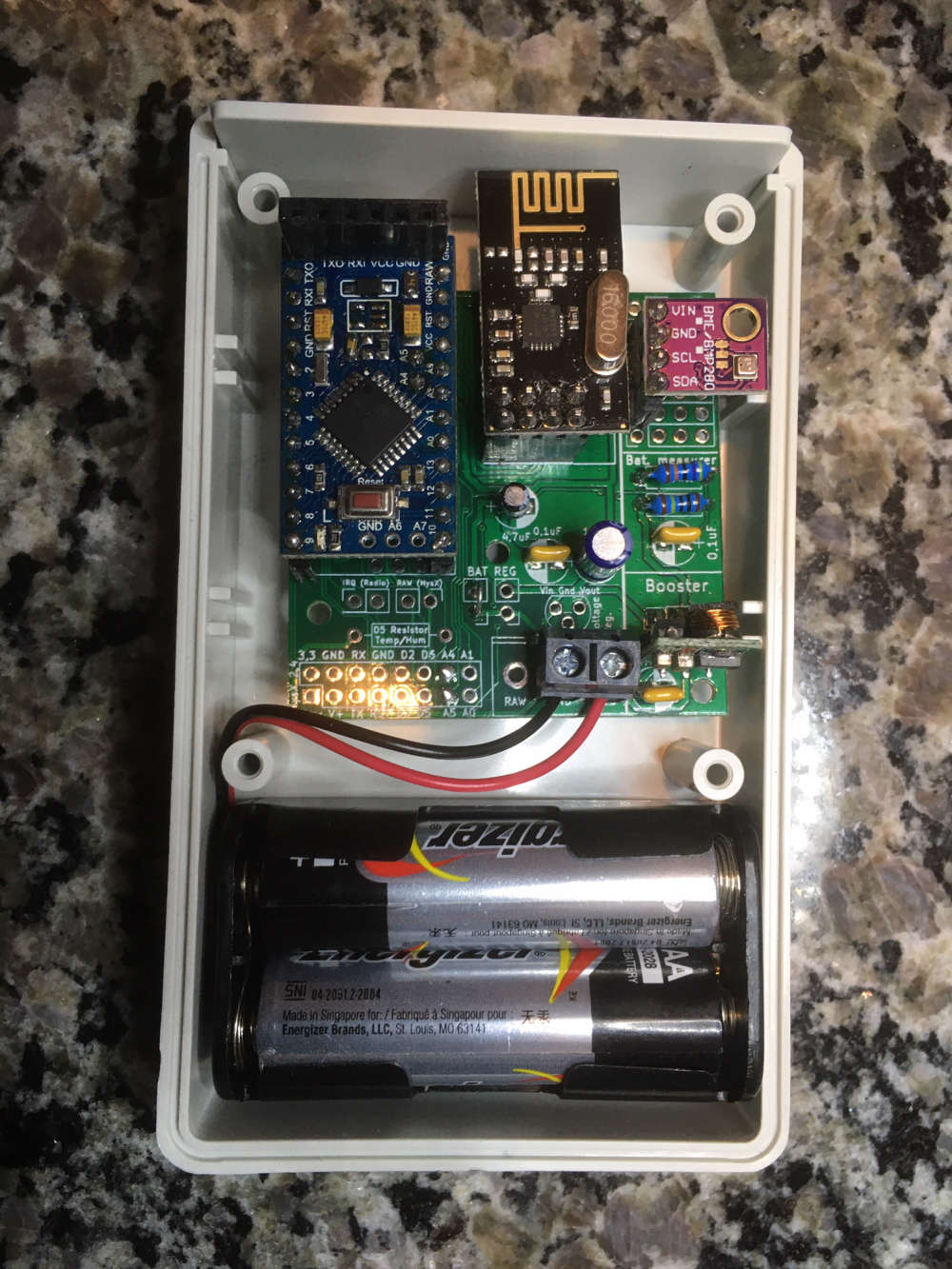
-
This post is deleted!
-
That project box is perfect! Where did you find it (it doesn't look printed)?
-
I got it from CPC in the UK which are owned by Farnell
https://cpc.farnell.com/hammond/1593qgy/case-with-bat-compart-110x66x28mm/dp/EN82140
You may have to make a slight mod to the board or enclosure to make it fit.
good luck